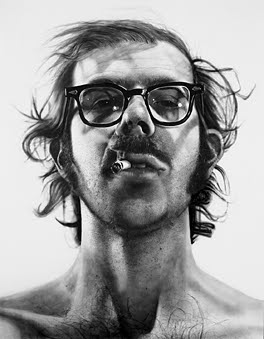Chuck Close is known for painting in a photorealism style. This style pushes detail to the extreme, as it closely resembles a photograph. The artist is able to capture and recreate an image by paying close attention to intricate detail and produce a piece in realistic quality. He created his “Big Self Portrait” with acrylic paint and airbrush on canvas using a grid technique with enlarged photographs to dissect the image and recreate in a larger scale with incredible accuracy and attention to
detail.
detail.
Many differences are very apparent between the self-portrait of Chuck Close and works of Gusstavus Hesselius. Maybe the most obvious of differences is the “Big Self Portrait” of Close is painted in black and white while Hesselius’s pieces are both in color. Also the other major difference is the style of Chuck Close’s photorealism shows greater detail of the figure and gives the viewer much more information. Closes understanding of the human figure is spot on and attention to shadows and light move is image to greater realism.
Hesselius seems to want to show is portraits in their glory. The chief with his blue garment and accessories hanging from his neck bordered by an oval show casing the image and the self portrait showing himself in an honored position of authority give both of these characters more of a feeling of awe and power. Chuck Close uses more of a raw gritty approach and does not glorify his portrait but rather appears to degrade it. We see that he even has a smoldering cigarette in his mouth. His hair is everywhere and we are not even sure he is clothed. Unshaven and unkempt it almost appears that Close wants his viewers to think he had just rolled out of bed. His haphazard appearance in the photo adds to the photorealistic quality created in his technique.
In trying to find similarities between the pieces a viewer can identify that all the figures are male, none of the figures are smiling, and the chief and Close’s self portrait are both created with the same view of the face. These two images are also more closely related as they do not have the figure with any furniture around them.
Looking at similarities and differences it can quickly be realized that Hesselius’s paintings really do not have much connection to the Chuck Close “Big Self Portrait”. While they are all paintings, Close’s photorealistic style really takes his piece in a different direction when comparing it to the works of Hesselius. From the perspective, realistic human form, color, and even over all appearance displayed in the portrait Chuck Close shows stark contrast to Hesselius in his self-portrait.

Chuck Close
Big Self Portrait
1967-1986
Acrylic on canvas.
107 1/2 x 83 1/2" (273 x 212 cm).
Walker Art Center, Minneapolis
(ArtsNet Minnesota, 2011)


(Common-place, 2011)
Works Cited:
"ArtsNet Minnesota: Identity: Chuck Close." ArtsConnectEd. Web. 06 Apr. 2011. .
Common-place. Web. 07 Apr. 2011. .
"MoMA.org | Interactives | Exhibitions | 1998 | Chuck Close." MoMA | The Museum of Modern Art. Web. 06 Apr. 2011..